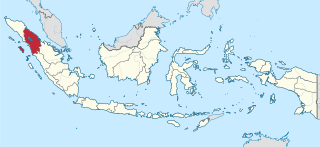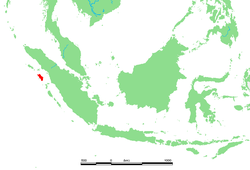
The Indonesian National Revolution, or the Indonesian War of Independence, was an armed conflict and diplomatic struggle between the Republic of Indonesia and the Dutch Empire and an internal social revolution during postwar and postcolonial Indonesia. It took place between Indonesia's declaration of independence in 1945 and the Netherlands' transfer of sovereignty over the Dutch East Indies to the Republic of the United States of Indonesia at the end of 1949.

North Sumatra is a province of Indonesia located on the northern part of the island of Sumatra. Its capital and largest city is Medan. North Sumatra is Indonesia's fourth most populous province after West Java, East Java and Central Java. It covers an area of 72,981 km2. According to the 2020 census, the province's population in that year was 14,799,361. The mid-2022 official estimate is 15,115,206.

Hubertus Johannes "Huib" van Mook was a Dutch administrator in the East Indies. During the Indonesian National Revolution, he served as the Acting Governor-General of the Dutch East Indies from 1942 to 1948. Van Mook also had a son named Cornelius van Mook who studied marine engineering at the Massachusetts Institute of Technology. He also wrote about Java - and his work on Kota Gede is a good example of a colonial bureaucrat capable of examining and writing about local folklore.

Walter Spies was a Russian-born German primitivist painter, composer, musicologist, and curator. In 1923 he moved to Java, Indonesia. He lived in Yogyakarta and then in Ubud, Bali starting from 1927, when Indonesia was under European colonial rule as the Dutch East Indies.

Nias is an island located off the western coast of Sumatra, Indonesia. Nias is also the name of the archipelago of which the island is the centre, but also includes the Batu Islands to the south-east and the small Hinako Islands to the west. Nias Island covers an area of 5,625.0 km2 (2,171.8 sq mi). It is mostly a lowland area rising to around 800 m (2,600 ft) above sea level. There were 756,338 inhabitants on the island at the 2010 Census; at the 2015 Census this had risen to 798,506 and the 2020 Census resulted in a total of 880,550. The official estimate as at mid 2022 was 902,632.

Sibolga is a city and a port located in the natural harbor of Sibolga Bay on the west coast of North Sumatra province, in Indonesia.
The 2005 Nias–Simeulue earthquake occurred on 28 March off the west coast of northern Sumatra, Indonesia. At least 915 people were killed, mostly on the island of Nias. The event caused panic in the region, which had already been devastated by the massive tsunami triggered by the 2004 Indian Ocean earthquake, but this earthquake generated a relatively small tsunami that caused limited damage. It was the third most powerful earthquake since 1965 in Indonesia.

Gunungsitoli is a city located in North Sumatra province, Indonesia, on the Indian Ocean island of Nias, west of Sumatra. Gunungsitoli is the island's only city and is the main hub for the island and surrounding smaller islands. Located on the north-eastern side of Nias island, the city was historically a series of fortifications made by the Dutch colonial administration in the 1600s to defend against frequent raids from Nias tribes, especially those from southern parts of the island. Until 1914, it was the only part of the island that was effectively controlled by the Dutch.

The Empire of Japan occupied the Dutch East Indies during World War II from March 1942 until after the end of the war in September 1945. It was one of the most crucial and important periods in modern Indonesian history.

The Omo sebua is a traditional house style of the Nias people from Nias island, Indonesia. They are built only for the houses of village's chiefs. Situated in the centre of a village, omo sebua are built on massive ironwood piles and have towering roofs. Nias culture, with former frequent inter-village warfare, has made the design of omo sebua impregnable to attack. The houses' sole access is through a narrow staircase with a small trap door above. The steeply pitched roofs can reach 16 metres in height. Apart from a strong defense against enemies, omo sebua have proven earthquake resistance.

Foreign relations of the Axis powers includes states which were not officially members of the Axis but had relations with one or more Axis members.

Sultanate of Deli was a 1,820 km² Malay state in east Sumatra founded in 1630. A tributary kingdom from 1630 it was controlled by various Sultanates until 1814, when it became an independent sultanate and broke away from the Sultanate of Siak.

Nias Regency is a regency in North Sumatra province, Indonesia; it lies on the east side of Nias Island. The regency originally covered the entire island, but was reduced to the northern half, with an area of 3,495.39 square kilometres, following the creation of the new regency of Nias Selatan in 2003. It was further reduced by the creation of the new regencies of Nias Utara and Nias Barat and the independent municipality of Gunungsitoli from other parts of Nias Regency on 29 October 2008. Since the separation of the new regencies and municipality, the reduced Regency now covers 853.44 km2 of land in the eastern part of the island, and had a population of 131,377 at the 2010 Census and 146,672 at the 2020 Census. The official estimate as at mid 2022 was 149,249. Its seat is the town of Gido.

The Dutch East Indies, also known as the Netherlands East Indies, was a Dutch colony consisting of what is now Indonesia. It was formed from the nationalised trading posts of the Dutch East India Company, which came under the administration of the Dutch government in 1800.

The Nias Expedition was a punitive expedition of the Royal Netherlands East Indies Army to Nias at the end of 1855, which, with intervals, lasted until 1864.

Toba people also referred to as Batak Toba people are the largest sub-group of the Batak people of North Sumatra, Indonesia. The common phrase of ‘Batak’ usually refers to the Batak Toba people. This mistake is caused by the Toba people being the largest sub-group of the Batak ethnic and their differing social habit has been to self-identify as merely Batak instead of ‘Toba’ or ‘Batak Toba’, contrary to the habit of the Karo, Mandailing, Simalungun, Pakpak communities who commonly self-identify with their respective sub-groups.
The following events occurred in March 1942:

The Dutch East Indies was a Dutch colony consisting of what is now Indonesia. It was divided into three governorates, namely the Great East, Borneo (Kalimantan) and Sumatra, and into three provinces in Java. Provinces and governorates were further divided into residencies. Residencies under the provinces were divided into regencies, and residencies under governorates were divided into departments and then further into regentschappen.

Raja Junjungan Lubis was an Indonesian Mandailing politician who became the Regent of Batanggadis, Regent of Central Tapanuli, Mayor of Sibolga, Governor of North Sumatra, and member of the People's Representative Council.

Tapanoeli Residency was an administrative subdivision of the Dutch East Indies with its capital in Sibolga. It was located in northern Sumatra and existed in various forms from 1844 until the end of Dutch rule in 1942. The area it encompassed at various times corresponds to most of the western coast of the current day Indonesian province of North Sumatra and parts of Aceh, including much of the traditional heartland of Batak people. Lake Toba, a historically important crater lake, was also within the borders of the Residency.




















